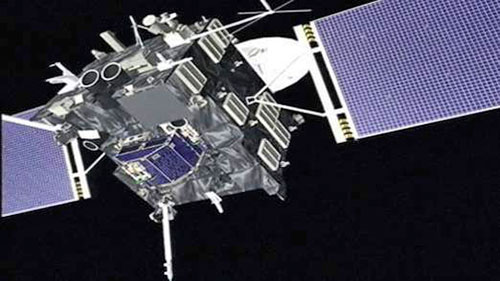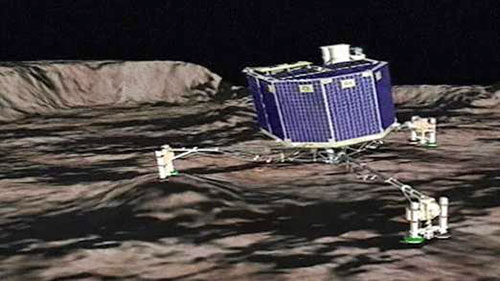|

19 January 2014
from
NewsSky Website
Scientists are comparing
Rosetta's mission to land on the hurtling
ball of ice,
to a fly trying to land on a speeding bullet.
67P/Churyumov-Gerasimenko
is hurtling through space at nearly 25,000mph
A spaceship is about to embark on one of the most technologically
advanced missions ever attempted - by landing on a comet at
24,600mph.
An internal alarm will wake the Rosetta craft at 10am today after
two and a half years of deep-space hibernation.
It will then chase
67P/Churyumov-Gerasimenko as it begins to move
closer to the Sun, before harpooning the 2.5-mile wide frozen
dirtball and trying to make a landing.
Project scientist Matt Taylor, from the European Space Agency
(ESA), compared the feat to the Bruce Willis film Armageddon in
which Willis lands on an asteroid to save the world from
destruction.

An ESA computer
animation of the Rosetta spaceship
"It will be an amazing achievement for human Endeavour, an
'Armageddon' type thing," he told the Sunday Telegraph.
"We're not just landing on the Moon, we're dealing with
something dynamic, which is kicking off tonnes of dust and gas
every minute."
Rosetta was launched in March 2004, from
Kourou, in French Guiana, and is now 500 million miles from Earth
and close to the orbit of Jupiter.
The comet is travelling at 24,600mph - far faster than a space ship
- so the ESA craft has spent the time since its launch using the
gravitational pull of the Earth and Mars to act as a sling shot and
allow it to accelerate.
"It flew almost 10 years in space
and in the last two and a half years it was so far from the sun
that we couldn't keep it completely active so we had to switch
it off," said Dr Paolo Ferri, head of the ESA's mission
operations department.

When Rosetta is
near the comet, it will launch its lander craft
"We have no contact since two and a half years and on Monday
we'll have the first signal since then."
Scientists compare Rosetta's mission to
a fly trying to land on a speeding bullet.
It will arrive at 67P in August, where if all goes to plan, it will
become the first spacecraft to orbit a comet and land a probe on its
surface.
Comets are the primitive building blocks of the solar system, and
are thought to have helped 'seed' Earth with water, and perhaps even
life. Their icy surface is embedded with dust, grit and particles
from space, NASA says.
They are left over from a planet-building time when our sun was just
a spinning disc of dust and gas.

An ESA animation of
the lander landing on the comet
By studying the comet's dust and gas, Rosetta will help scientists
learn more about the evolution of the solar system, it is hoped.
"Over the millennia of the history
of Earth, comets have actually affected our evolution, they
probably have affected the evolution of life as well, from the
start of life to the destruction of life," Dr Ferri said.
"There are many theories about comets hitting the earth and
causing global catastrophes. So understanding comets is also
important to see in the future what could be done to defend the
earth from comets."
|



